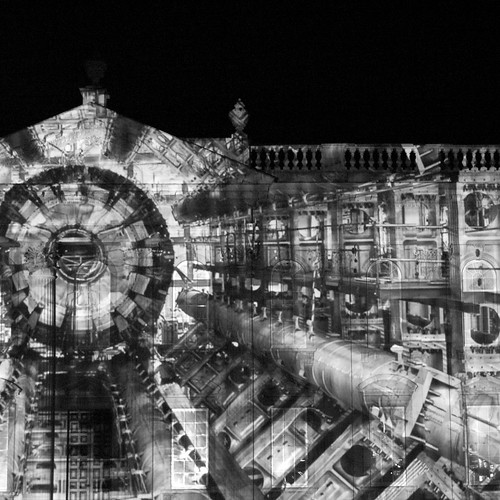 Ricoeur's De l'Interpretation (translated as Freud and Philosophy), is famous for introducing a distinction between hermeneutics of suspicion--whose practitioners are the three bad boys of Western civilization: Marx, Nietzsche, and Freud--and a restorative hermeneutics or hermeneutics of recollection. The goal of the book is not to oppose one to the other, but to take the latter, with which he aligns both faith and phenomenology (specifically in the phenomenology of religion, the object of which is the sacred--the essence of ritual, belief, and culture), and have it pass through the former. This is not because faith is inadequate, but because the hermeneutic tradition "is at variance with itself" (27), or has already split between the two, and thus has something perhaps to bring to suspicion.
Ricoeur's De l'Interpretation (translated as Freud and Philosophy), is famous for introducing a distinction between hermeneutics of suspicion--whose practitioners are the three bad boys of Western civilization: Marx, Nietzsche, and Freud--and a restorative hermeneutics or hermeneutics of recollection. The goal of the book is not to oppose one to the other, but to take the latter, with which he aligns both faith and phenomenology (specifically in the phenomenology of religion, the object of which is the sacred--the essence of ritual, belief, and culture), and have it pass through the former. This is not because faith is inadequate, but because the hermeneutic tradition "is at variance with itself" (27), or has already split between the two, and thus has something perhaps to bring to suspicion.How has it split? The Aristotelian problem of semantics understands the sentence as "saying something of something," or declaring something about being, understood already as meaningful and needing clarification or rather elucidation, proclamation. Such a stance recognizes that "real meanings are indirect" because "I attain things only by attributing a meaning to a meaning" (23). Clarification here primarily revolves around circumscribing the possibility for error, for attributing meaning in a false way. But it never presumes error can be overcome: Aristotle says in the Metaphysics that "being is said in several ways" (23). However, it does not directly attempt to take up the complete range of meanings itself. This is the task of the second branch of the hermeneutic tradition. Here, we have the sentence as Scripture, introduced by the Christian community (there is a notable absence of the Rabbinical tradition in Ricoeur's account) and then as text (via the "book of nature"), as something articulated in many ways and only able to be reduced because it unfolds according to specific forms (like allegory and analogy). These must be understood in themselves to allow the sentence to be understood. In this view, the falsity of a sentence becomes not only a covering up of the true, but the creation of a new direction which leads one astray from the truth and back into the plurality of meaning--that is, the replacement of an intelligible text not with a more intelligible text (which is the goal of this criticism), but a less intelligible text. Thus the process of unfolding meaning is an attempt to get past lying and towards the authoritative version of something.
Ricoeur's goal is not, then, to reunite the hermeneutic field through some "general hermeneutics," some "universal canon for exegesis" (27; we might see Gadamer trying something like this), but rather to make this "conflict of interpretations" work for philosophy, or resolve a more total "crisis of reflection"--something I won't really get into now but is quite interesting in itself and ultimately necessary for understanding the whole of this famous distinction between the suspicious and the restorative.
Now, Freud has both the suspicious and the restorative elements in him. He always pushes his theory, though, towards the suspicious. But certain elements escape this. Ricoeur recognizes these elements lie in the connections Freud makes to culture in order to give a the psyche and its mechanisms some recognizably anthropological basis. As far as the psyche is concerned, Freud asserts we can do without them. But in his texts, they function as more than mere hypotheses. Oedipus, for example, isn't just some sort of empty structure that happens to have been represented in literature. Freud has recourse to it because it has enough thickness to give a certain character to the psychic mechanisms.
Ricoeur pushes hard on these "symbols," as he calls them, and the results are amazing: the view of Freud that he comes up with eventually accounts for so much that remains embarrassing and unexplained in early psychoanalysis, and which subsequent theories have had to scramble to make more rigorous (or more confusing). The symbolic (which we should distinguish from the Lacanian symbolic) pops up not just in these "literary" references, but in the most basic elements of the Freudian approach. Ricoeur sees even the move between the economic and the topographical as a negotiation of the symbolic--indeed this is his central concern, since such a move constitutes, for Freud, the dream-work itself, and thus (when it is itself worked upon) the process of the interpretation of dreams.
One can't convey just how novel, and how refreshing, Ricoeur's approach is. The economic/topographical distinction is of immense importance, and is too often bypassed as simply the relationship of two unconnected regions, one of which can always be reduced to the terms of the other. Ricoeur makes the distinction the center of his reading, and by connecting the 1895 "Sketch for a Scientific Psychology" to the Interpretation of Dreams, patiently shows how the solely economic considerations of the former are developed into the topographical considerations in the latter. It is through the notion that the economic constitutes a discourse of force, and the second a discourse of meaning, that we return to the distinction between a hermeneutics of suspicion and restoration. For what Freud does is interpret the second discourse in terms of the first, continually. In other words, meaning will always be seen as having its origin in force, never in another meaning. Or, more accurately, when meaning has its origin in another meaning, this process will always be seen as itself originating in the movement of forces. And it is in this way that the dream work itself will be seen as something in need of unworking, demystifying--in short, will require a hermeneutics of suspicion.
To interpret is to displace the origin of meaning to another region. The topography, at least in its static and properly topographical from, will be the pictorial representation of this movement of interpretation from the apparent meaning towards another locality of meaning. But even at this first level it is impossible to look upon Deutung as a simple relation between ciphered and deciphered discourse; it is not enough to say that the unconscious is another discourse, and unintelligible discourse. In its transposition or distortion (Verstellung) of the manifest content into the latent content, interpretation uncovers another distortion, that of desires into images...
-Freud and Philosophy, 91-2
Thus, we get a mixed discourse, which tends to conceive the unconscious as the proper object of suspicion, even as it forces meaning, the object of a restorative hermeneutic, into its service:
To say that a dream is the fulfillment of a repressed wish is to put together two notions which belong to different orders: fulfillment (Erfüllung), which belongs to the discourse of meaning (as attested by Husserl's use of the term), and repression (Verdrängung), which belongs to the discourse of force. The notion of Verstellung, which combines the two universes of discourse, expresses the fusion of these two concepts, for a disguise is a type of manifestation and, at the same time, a distortion that alters that manifestation: it is the violence done to the meaning. Thus the relation of the hidden to the shown in the notion of disguise requires a deformation, a disfiguration, which can only be stated as a compromise of forces.
-Freud and Philosophy, 92
But when Freud looks at things like typical dreams (dreams of being naked, etc.), or when he finds that certain objects or figures typically represent certain desires, he is left confused: he has to express some larger economic principle underlying these symbols. What Ricoeur does is pose the question of why indeed the dream process in its entirety has to be seen as opposed to such symbolic manifestations. For in them, what we find is a sort of relationship to otherness that is opaque and cannot easily be demystified: one has to foist upon them a certain amount of mystification which is ultimately not present in them--merely because they have already been worked upon elsewhere. They can only have their essence specified--this is what the phenomenology of religion does, for example, with symbols. And this is why the latter is a hermeneutic of restoration. It deals with meaning not by seeing in it a distortion of its own real meaning--its own authoritative truth--but rather the expression of a more general plurivocal essence that allows for all sorts of meanings, all sorts of aspects to be grasped (through the fact that their meaning is not manifest, or rather is also present somewhere other than in their manifestation, their immediate meaning). Ricoeur then proposes to reintroduce this dimension within analysis, not to undo the Freudian contribution, but to bend it back to accommodate the full range of possible meanings. I'll have to stop here, but this hopefully can serve at least as a little sketch of the whole project.









